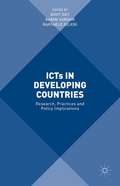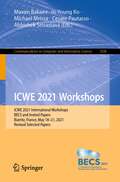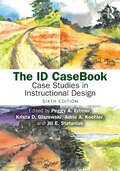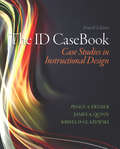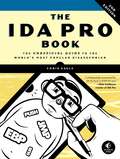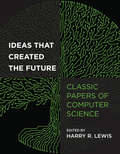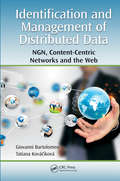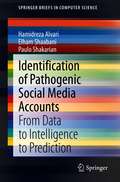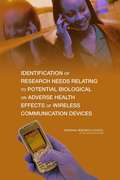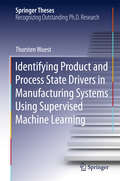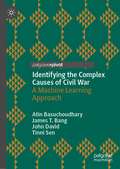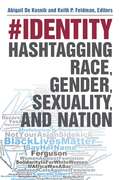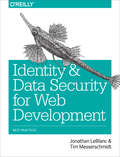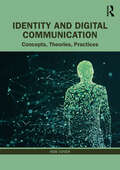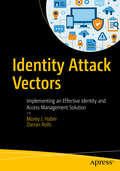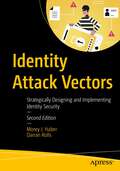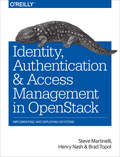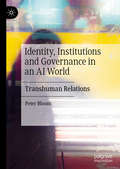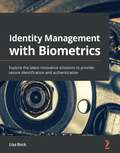- Table View
- List View
ICTs in Developing Countries: Research, Practices and Policy Implications
by Bidit Dey Karim Sorour Raffaele FilieriICTs in Developing Countries is a collection of conceptual and empirical works on the adoption and impacts of ICT use in developing societies. Bringing together a wide range of disciplines and contributors, it offers a rich examination of digital divide and ICT for development both in terms of contextual information and disciplinary perspectives.
ICWE 2021 Workshops: ICWE 2021 International Workshops, BECS and Invited Papers, Biarritz, France, May 18–21, 2021, Revised Selected Papers (Communications in Computer and Information Science #1508)
by Maxim Bakaev In-Young Ko Michael Mrissa Cesare Pautasso Abhishek SrivastavaThis book constitutes the thoroughly refereed post-workshop proceedings of the 21th International Conference on Web Engineering, ICWE 2021, held in Biarritz, France, in May 2021.*The first international workshop on Big data-driven Edge Cloud Services (BECS 2021) was held to provide a venue in which scholars and practitioners can share their experiences and present on-going work on providing value-added Web services for users by utilizing big data in edge cloud environments. The 5 revised full papers and 1 revised short contribution selected from 11 submissions are presented with 2 invited papers.*The conference was held virtually due to the COVID-19 pandemic.
The ID CaseBook: Case Studies in Instructional Design
by Peggy A. Ertmer Krista D. Glazewski Jill E. Stefaniak Adrie A. KoehlerThe ID CaseBook provides instructional design students with 25 realistic, open-ended case studies that encourage adept problem-solving across a variety of client types and through all stages of the process. After an introduction to the technique of case-based reasoning, the book offers four sections dedicated to K–12, informal learning, post-secondary, and industry clients, respectively, each comprising varied, detailed cases created by instructional design experts. All cases, alongside their accompanying discussion questions, encourage students to analyze the available information, develop action plans, and consider alternative possibilities in resolving problems. This revised and updated sixth edition attends to the profound impacts that public health crises; urgent access, equity, and inclusion needs among diverse learners; and a rapidly expanded reliance on digital learning formats have had on the design of learning today.
The ID CaseBook: Case Studies in Instructional Design
by Peggy A. Ertmer James A. Quinn Krista D. GlazewskiFirst Published in 2017. Routledge is an imprint of Taylor & Francis, an Informa company.The Fourth Edition of this highly regarded problem-solving text presents 30 realistic case studies in a wide range of authentic contexts, from K-12 to post-secondary, corporate, and manufacturing. The cases and their accompanying discussion questions encourage ID students to analyze the available information, develop conclusions, and consider alternative possibilities in resolving ID problems.
The IDA Pro Book: The Unofficial Guide to the World's Most Popular Disassembler (Second Edition)
by Chris Eagle<P>No source code? No problem. With IDA Pro, the interactive disassembler, you live in a source code-optional world. IDA can automatically analyze the millions of opcodes that make up an executable and present you with a disassembly. But at that point, your work is just beginning. With The IDA Pro Book, you'll learn how to turn that mountain of mnemonics into something you can actually use. <P>Hailed by the creator of IDA Pro as "profound, comprehensive, and accurate," the second edition of The IDA Pro Book covers everything from the very first steps to advanced automation techniques. You'll find complete coverage of IDA's new Qt-based user interface, as well as increased coverage of the IDA debugger, the Bochs debugger, and IDA scripting (especially using IDAPython). But because humans are still smarter than computers, you'll even learn how to use IDA's latest interactive and scriptable interfaces to your advantage. <P>Save time and effort as you learn to: <br>–Navigate, comment, and modify disassembly <br>–Identify known library routines, so you can focus your analysis on other areas of the code <br>–Use code graphing to quickly make sense of cross references and function calls <br>–Extend IDA to support new processors and filetypes using the SDK <br>–Explore popular plug-ins that make writing IDA scripts easier, allow collaborative reverse engineering, and much more <br>–Use IDA's built-in debugger to tackle hostile and obfuscated code <P>Whether you're analyzing malware, conducting vulnerability research, or reverse engineering software, a mastery of IDA is crucial to your success. Take your skills to the next level with this 2nd edition of The IDA Pro Book.
Ideas de Internet: ¡Formas de convertirse en parte de la comunidad en línea! (Cómo... #124)
by Owen JonesBienvenido a "Ideas de Internet " – un manual de principiantes, tu guía para dominar el ámbito digital con confianza y comprensión. . Internet se ha convertido en una herramienta esencial para comunicación, aprendizaje y entretenimiento. Como experto en todo lo relacionado con Internet, estoy encantado de ser tu guía en este aleccionador viaje. Este manual se creó meticulosamente elaborado para proveer a los principiantes con bases sólidas para recorrer el vasto entorno de Internet. Bien sea que te estás conectando por primera vez, o buscas profundizar tu conocimiento, esta guía te fortalecerá para navegar con facilidad y tomar decisiones con fundamento. Ten la seguridad de que toda la información que aquí se presenta es exacta y está basada en los conocimientos más recientes. El Internet, aunque increíblemente poderoso, puede ser complejo, pero al embarcarse juntos en esta aventura, te estás preparando para el éxito. Adquiere las habilidades y la sabiduría que necesitas para sacar el máximo partido de la era digital, manteniendo los valores de la verdad y la integridad. ¡Comencemos a explorar las infinitas posibilidades de Internet! Espero que la información te resulte útil, provechosa y redituable.
Ideas for the Animated Short: Finding and Building Stories
by Karen Sullivan Gary SchumerFollow from start to finish the creation of an animated short from the pre-production thought process to story development and character design. Explore the best practices and avoid the common pitfalls of creating two to five minute shorts. Watch a specially created animated short, demonstrating the core techniques and principles at the companion website! Packed with illustrated examples of idea generation, character and story development, acting, dialogue and storyboarding practice this is your conceptual toolkit proven to meet the challenges of this unique art form. The companion website includes in-depth interviews with industry insiders, 18 short animations (many with accompanying animatics, character designs and environment designs) and an acting workshop to get your animated short off to a flying start! With all NEW content on script writing, acting, sound design and visual storytelling as well as stereoscopic 3D storytelling, further enhance your animated shorts and apply the industry best practices to your own projects and workflows.
Ideas That Created the Future: Classic Papers of Computer Science
by Harry R. LewisClassic papers by thinkers ranging from from Aristotle and Leibniz to Norbert Wiener and Gordon Moore that chart the evolution of computer science.Ideas That Created the Future collects forty-six classic papers in computer science that map the evolution of the field. It covers all aspects of computer science: theory and practice, architectures and algorithms, and logic and software systems, with an emphasis on the period of 1936-1980 but also including important early work. Offering papers by thinkers ranging from Aristotle and Leibniz to Alan Turing and Nobert Wiener, the book documents the discoveries and inventions that created today's digital world. Each paper is accompanied by a brief essay by Harry Lewis, the volume's editor, offering historical and intellectual context.
Ideen Für Passive Einkommen: 50 Wege um Online Geld Zu Machen Analysiert
by Michael EzeanakaViele Menschen machen den Fehler, passives Einkommen mit dem schnellen Geld gleichzusetzen. Ich hoffe, dass Sie nicht denselben Fehler machen. Aus diesem Grund habe ich diesen Leitfaden über die gängigsten Möglichkeiten, passives Einkommen zu erzielen, zusammengestellt. Meine Absicht ist es, Ihnen bei der Entscheidung zu helfen, ob eine Gelegenheit für Sie geeignet ist oder nicht. Ich möchte Ihnen auch dabei helfen, die Mythen und Missverständnisse rund um diese einkommensschaffenden Methoden zu entlarven. Die Informationen und Analysen, die Sie in diesem Buch finden, beruhen auf Fakten und beobachtbaren Trends. Ich möchte sicherstellen, dass Sie auf dem richtigen Weg sind, wenn Sie sich schließlich entscheiden, einen Weg zu finden, passives Einkommen zu generieren.
Ideias Para a Internet: Formas de fazer parte da comunidade online! (Como faz... #124)
by Owen JonesFormas de fazer parte da comunidade online e se atualizar com o século 21! Ideias para a Internet Bem-vindo ao "Ideias para a Internet" - um manual para iniciantes, seu guia para dominar o mundo digital com confiança e compreensão. No mundo interconectado de hoje, a Internet tornou-se uma ferramenta essencial para comunicação, aprendizado e entretenimento. Como especialista experiente em tudo o que envolve a internet, estou empolgado por ser seu guia nesta jornada esclarecedora. Este manual foi meticulosamente elaborado para fornecer aos iniciantes uma base sólida para atravessar a vasta paisagem da Internet. Esteja você se conectando pela primeira vez ou buscando aprofundar seus conhecimentos, este guia permitirá que você navegue com facilidade e tome decisões informadas. Tenha a certeza de que cada pedaço de informação apresentado aqui está enraizado na precisão e nas últimas perspectivas. A Internet, embora incrivelmente poderosa, pode ser complexa, mas ao embarcar nesta aventura juntos, você está se preparando para o sucesso. Equipe-se com as habilidades e sabedoria necessárias para aproveitar ao máximo a era digital, mantendo os valores da verdade e da integridade. Vamos começar nossa exploração das possibilidades ilimitadas da Internet! Espero que você ache as informações úteis, proveitosas e lucrativas.
Identification and Management of Distributed Data: NGN, Content-Centric Networks and the Web
by Giovanni Bartolomeo Tatiana KovacikovaAlthough several books and academic courses discuss data management and networking, few of them focus on the convergence of networking and software technologies for identifying, addressing, and managing distributed data. Focusing on this convergence, Identification and Management of Distributed Data: NGN, Content-Centric Networks and the Web collat
Identification and Mitigation of Fraudulent Online Transactions Using Authentication and Fraud Detection System (Studies in Smart Technologies)
by Vipin Khattri Sandeep Kumar Nayak Deepak Kumar Singh Vikrant BhatejaThe book explores comprehensive demonstration of the performance analytics following the implementation of the authentication and fraud detection system strategies. These evaluations are based on different performance metrics such as accuracy, true positive rate, true negative rate, precision, g-mean, f1-score and receiver operating characteristic curve. This book highlights effectiveness of the implemented authentication and fraud detection system based on their performance statistics. Additionally, it explores the limitations and social impact of the developed online transaction system, offering insights into potential areas for future research.
Identification of Pathogenic Social Media Accounts: From Data to Intelligence to Prediction (SpringerBriefs in Computer Science)
by Hamidreza Alvari Elham Shaabani Paulo ShakarianThis book sheds light on the challenges facing social media in combating malicious accounts, and aims to introduce current practices to address the challenges. It further provides an in-depth investigation regarding characteristics of “Pathogenic Social Media (PSM),”by focusing on how they differ from other social bots (e.g., trolls, sybils and cyborgs) and normal users as well as how PSMs communicate to achieve their malicious goals. This book leverages sophisticated data mining and machine learning techniques for early identification of PSMs, using the relevant information produced by these bad actors. It also presents proactive intelligence with a multidisciplinary approach that combines machine learning, data mining, causality analysis and social network analysis, providing defenders with the ability to detect these actors that are more likely to form malicious campaigns and spread harmful disinformation. Over the past years, social media has played a major role in massive dissemination of misinformation online. Political events and public opinion on the Web have been allegedly manipulated by several forms of accounts including “Pathogenic Social Media (PSM)” accounts (e.g., ISIS supporters and fake news writers). PSMs are key users in spreading misinformation on social media - in viral proportions. Early identification of PSMs is thus of utmost importance for social media authorities in an effort toward stopping their propaganda. The burden falls to automatic approaches that can identify these accounts shortly after they began their harmful activities. Researchers and advanced-level students studying and working in cybersecurity, data mining, machine learning, social network analysis and sociology will find this book useful. Practitioners of proactive cyber threat intelligence and social media authorities will also find this book interesting and insightful, as it presents an important and emerging type of threat intelligence facing social media and the general public.
Identification Of Research Needs Relating To Potential Biological Or Adverse Health Effects Of Wireless Communication Devices
by National Research Council of the National AcademiesIn recent years there has been a rapid increase in the use of wireless communications devices and a great deal of research has been carried out to investigate possible biological or human health effects resulting from their use. The U.S. Food and Drug Administration asked the National Research Council to organize a workshop to identify research needs and gaps in knowledge in the areas of dosimetry and exposure, epidemiology, human laboratory studies, mechanisms, and animal and cell biology. The workshop did not include the evaluation of health effects or the generation of recommendations relating to how identified research needs should be met. Some needs and gaps identified at the workshop include: (1) characterization of exposures from wireless devices and RF base station antennas in juveniles, children, fetuses, and pregnant women and (2) evaluation of devices that use newer technologies (e.g., texting, web-surfing).
Identifying Product and Process State Drivers in Manufacturing Systems Using Supervised Machine Learning
by Thorsten WuestThe book reports on a novel approach for holistically identifying the relevant state drivers of complex, multi-stage manufacturing systems. This approach is able to utilize complex, diverse and high-dimensional data sets, which often occur in manufacturing applications, and to integrate the important process intra- and interrelations. The approach has been evaluated using three scenarios from different manufacturing domains (aviation, chemical and semiconductor). The results, which are reported in detail in this book, confirmed that it is possible to incorporate implicit process intra- and interrelations on both a process and programme level by applying SVM-based feature ranking. In practice, this method can be used to identify the most important process parameters and state characteristics, the so-called state drivers, of a manufacturing system. Given the increasing availability of data and information, this selection support can be directly utilized in, e. g. , quality monitoring and advanced process control. Importantly, the method is neither limited to specific products, manufacturing processes or systems, nor by specific quality concepts.
Identifying the Complex Causes of Civil War: A Machine Learning Approach
by Atin Basuchoudhary James T. Bang John David Tinni SenThis book uses machine-learning to identify the causes of conflict from among the top predictors of conflict. This methodology elevates some complex causal pathways that cause civil conflict over others, thus teasing out the complex interrelationships between the most important variables that cause civil conflict. Success in this realm will lead to scientific theories of conflict that will be useful in preventing and ending civil conflict. After setting out a current review of the literature and a case for using machine learning to analyze and predict civil conflict, the authors lay out the data set, important variables, and investigative strategy of their methodology. The authors then investigate institutional causes, economic causes, and sociological causes for civil conflict, and how that feeds into their model. The methodology provides an identifiable pathway for specifying causal models. This book will be of interest to scholars in the areas of economics, political science, sociology, and artificial intelligence who want to learn more about leveraging machine learning technologies to solve problems and who are invested in preventing civil conflict.
#identity: Hashtagging Race, Gender, Sexuality, and Nation
by Abigail De Kosnik Keith FeldmanSince its launch in 2006, Twitter has served as a major platform for political performance, social justice activism, and large-scale public debates over race, ethnicity, gender, sexuality, and nationality. It has empowered minoritarian groups to organize protests, articulate often-underrepresented perspectives, and form community. It has also spread hashtags that have been used to bully and silence women, people of color, and LGBTQ people. #identity is among the first scholarly books to address the positive and negative effects of Twitter on our contemporary world. Hailing from diverse scholarly fields, all contributors are affiliated with The Color of New Media, a scholarly collective based at the University of California, Berkeley. The Color of New Media explores the intersections of new media studies, critical race theory, gender and women’s studies, and postcolonial studies. The essays in #identity consider topics such as the social justice movements organized through #BlackLivesMatter, #Ferguson, and #SayHerName; the controversies around #WhyIStayed and #CancelColbert; Twitter use in India and Africa; the integration of hashtags such as #nohomo and #onfleek that have become part of everyday online vernacular; and other ways in which Twitter has been used by, for, and against women, people of color, LGBTQ, and Global South communities. Collectively, the essays in this volume offer a critically interdisciplinary view of how and why social media has been at the heart of US and global political discourse for over a decade.
Identity and Data Security for Web Development: Best Practices
by Jonathan LeBlanc Tim MesserschmidtDevelopers, designers, engineers, and creators can no longer afford to pass responsibility for identity and data security onto others. Web developers who don’t understand how to obscure data in transmission, for instance, can open security flaws on a site without realizing it. With this practical guide, you’ll learn how and why everyone working on a system needs to ensure that users and data are protected.Authors Jonathan LeBlanc and Tim Messerschmidt provide a deep dive into the concepts, technology, and programming methodologies necessary to build a secure interface for data and identity—without compromising usability. You’ll learn how to plug holes in existing systems, protect against viable attack vectors, and work in environments that sometimes are naturally insecure.Understand the state of web and application security todayDesign security password encryption, and combat password attack vectorsCreate digital fingerprints to identify users through browser, device, and paired device detectionBuild secure data transmission systems through OAuth and OpenID ConnectUse alternate methods of identification for a second factor of authenticationHarden your web applications against attackCreate a secure data transmission system using SSL/TLS, and synchronous and asynchronous cryptography
Identity and Digital Communication: Concepts, Theories, Practices
by Rob CoverThis comprehensive text explores the relationship between identity, subjectivity and digital communication, providing a strong starting point for understanding how fast-changing communication technologies, platforms, applications and practices have an impact on how we perceive ourselves, others, relationships and bodies. Drawing on critical studies of identity, behaviour and representation, Identity and Digital Communication demonstrates how identity is shaped and understood in the context of significant and ongoing shifts in online communication. Chapters cover a range of topics including advances in social networking, the development of deepfake videos, intimacies of everyday communication, the emergence of cultures based on algorithms, the authenticities of TikTok and online communication’s setting as a site for hostility and hate speech. Throughout the text, author Rob Cover shows how the formation and curation of self-identity is increasingly performed and engaged with through digital cultural practices, affirming that these practices must be understood if we are to make sense of identity in the 2020s and beyond. Featuring critical accounts, everyday examples and analysis of key platforms such as TikTok, this textbook is an essential primer for scholars and students in media studies, psychology, cultural studies, sociology, anthropology, computer science, as well as health practitioners, mental health advocates and community members.
Identity and Play in Interactive Digital Media: Ergodic Ontogeny (Routledge Advances in Game Studies)
by Sara M. ColeRecent shifts in new literacy studies have expanded definitions of text, reading/viewing, and literacy itself. The inclusion of non-traditional media forms is essential, as texts beyond written words, images, or movement across a screen are becoming ever more prominent in media studies. Included in such non-print texts are interactive media forms like computer or video games that can be understood in similar, though distinct, terms as texts that are read by their users. This book examines how people are socially, culturally, and personally changing as a result of their reading of, or interaction with, these texts. This work explores the concept of ergodic ontogeny: the mental development resulting from interactive digital media play experiences causing change in personal identity.
Identity Attack Vectors: Implementing an Effective Identity and Access Management Solution
by Morey J. Haber Darran RollsDiscover how poor identity and privilege management can be leveraged to compromise accounts and credentials within an organization. Learn how role-based identity assignments, entitlements, and auditing strategies can be implemented to mitigate the threats leveraging accounts and identities and how to manage compliance for regulatory initiatives.As a solution, Identity Access Management (IAM) has emerged as the cornerstone of enterprise security. Managing accounts, credentials, roles, certification, and attestation reporting for all resources is now a security and compliance mandate. When identity theft and poor identity management is leveraged as an attack vector, risk and vulnerabilities increase exponentially. As cyber attacks continue to increase in volume and sophistication, it is not a matter of if, but when, your organization will have an incident. Threat actors target accounts, users, and their associated identities, to conduct their malicious activities through privileged attacks and asset vulnerabilities. Identity Attack Vectors details the risks associated with poor identity management practices, the techniques that threat actors and insiders leverage, and the operational best practices that organizations should adopt to protect against identity theft and account compromises, and to develop an effective identity governance program. What You Will Learn Understand the concepts behind an identity and how their associated credentials and accounts can be leveraged as an attack vectorImplement an effective Identity Access Management (IAM) program to manage identities and roles, and provide certification for regulatory complianceSee where identity management controls play a part of the cyber kill chain and how privileges should be managed as a potential weak linkBuild upon industry standards to integrate key identity management technologies into a corporate ecosystemPlan for a successful deployment, implementation scope, measurable risk reduction, auditing and discovery, regulatory reporting, and oversight based on real-world strategies to prevent identity attack vectors Who This Book Is For Management and implementers in IT operations, security, and auditing looking to understand and implement an identity access management program and manage privileges in these environments
Identity Attack Vectors: Strategically Designing and Implementing Identity Security, Second Edition
by Morey J. Haber Darran RollsToday, it’s easier for threat actors to simply log in versus hack in. As cyberattacks continue to increase in volume and sophistication, it’s not a matter of if, but when, your organization will have an incident. Threat actors target accounts, users, and their associated identities—whether human or machine, to initiate or progress their attack. Detecting and defending against these malicious activities should be the basis of all modern cybersecurity initiatives.This book details the risks associated with poor identity security hygiene, the techniques that external and internal threat actors leverage, and the operational best practices that organizations should adopt to protect against identity theft, account compromises, and to develop an effective identity and access security strategy. As a solution to these challenges, Identity Security has emerged as a cornerstone of modern Identity and Access Management (IAM) initiatives. Managing accounts, credentials, roles, entitlements, certifications, and attestation reporting for all identities is now a security and regulatory compliance requirement. In this book, you will discover how inadequate identity and privileged access controls can be exploited to compromise accounts and credentials within an organization. You will understand the modern identity threat landscape and learn how role-based identity assignments, entitlements, and auditing strategies can be used to mitigate the threats across an organization’s entire Identity Fabric. What You Will Learn Understand the concepts behind an identity and how its associated credentials and accounts can be leveraged as an attack vectorImplement an effective identity security strategy to manage identities and accounts based on roles and entitlements, including the most sensitive privileged accountsKnow the role that identity security controls play in the cyber kill chain and how privileges should be managed as a potential weak linkBuild upon industry standards and strategies such as Zero Trust to integrate key identity security technologies into a corporate ecosystemPlan for a successful identity and access security deployment; create an implementation scope and measurable risk reduction; design auditing, discovery, and regulatory reporting; and develop oversight based on real-world strategies to prevent identity attack vectors Who This Book Is For Management and implementers in IT operations, security, and auditing looking to understand and implement an Identity and Access Management (IAM) program and manage privileges in these environments
Identity, Authentication, and Access Management in OpenStack: Implementing and Deploying Keystone
by Steve Martinelli Henry Nash Brad TopolKeystone—OpenStack's Identity service—provides secure controlled access to a cloud’s resources. In OpenStack environments, Keystone performs many vital functions, such as authenticating users and determining what resources users are authorized to access.Whether the cloud is private, public, or dedicated, access to cloud resources and security is essential. This practical guide to using Keystone provides detailed, step-by-step guidance to creating a secure cloud environment at the Infrastructure-as-a-Service layer—as well as key practices for safeguarding your cloud's ongoing security.Learn about Keystone's fundamental capabilities for providing Identity, Authentication, and Access ManagementPerform basic Keystone operations, using concrete examples and the latest version (v3) of Keystone's Identity APIUnderstand Keystone's unique support for multiple token formats, including how it has evolved over timeGet an in-depth explanation of Keystone's LDAP support and how to configure Keystone to integrate with LDAPLearn about one of Keystone's most sought-after features—support for federated identity
Identity, Institutions and Governance in an AI World: Transhuman Relations
by Peter BloomThe 21st century is on the verge of a possible total economic and political revolution. Technological advances in robotics, computing and digital communications have the potential to completely transform how people live and work. Even more radically, humans will soon be interacting with artificial intelligence (A.I.) as a normal and essential part of their daily existence. What is needed now more than ever is to rethink social relations to meet the challenges of this soon-to-arrive "smart" world. This book proposes an original theory of trans-human relations for this coming future. Drawing on insights from organisational studies, critical theory, psychology and futurism - it will chart for readers the coming changes to identity, institutions and governance in a world populated by intelligent human and non-human actors alike. It will be characterised by a fresh emphasis on infusing programming with values of social justice, protecting the rights and views of all forms of "consciousness" and creating the structures and practices necessary for encouraging a culture of "mutual intelligent design". To do so means moving beyond our anthropocentric worldview of today and expanding our assumptions about the state of tomorrow's politics, institutions, laws and even everyday existence. Critically such a profound shift demands transcending humanist paradigms of a world created for and by humans and instead opening ourselves to a new reality where non-human intelligence and cyborgs are increasingly central.
Identity Management with Biometrics: Explore the latest innovative solutions to provide secure identification and authentication
by Lisa BockIdentity Management with Biometrics is for IT managers, security professionals, students, teachers, and anyone involved in selecting, purchasing, integrating, or securing a biometric system. This book will help you understand how to select the right biometric system for your organization and walk you through the steps for implementing identity management and authentication. A basic understanding of biometric authentication techniques, such as fingerprint and facial recognition, and the importance of providing a secure method of authenticating an individual will help you make the most of the book.
